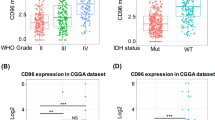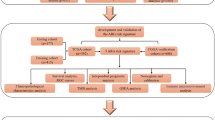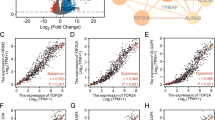Abstract
Lower grade gliomas (LGGs) with codeletion of chromosomal arms 1p and 19q (1p/19 codeletion) have a favorable outcome. However, its overall survival (OS) varies. Here, we established an immune signature associated with 1p/19q codeletion for accurate prediction of prognosis of LGGs. The Chinese Glioma Genome Atlas (CGGA) and The Cancer Genome Atlas (TCGA) databases with RNA sequencing and corresponding clinical data were dichotomized into training group and testing group. The immune-related differentially expressed genes (DEGs) associated with 1p/19q codeletion were screened using Cox proportional hazards regression analyses. A prognostic signature was established using dataset from CGGA and tested in TCGA database. Subsequently, we explored the correlation between the prognostic signature and immune response. Thirteen immune genes associated with 1p/19q codeletion were used to construct a prognostic signature. The 1-, 3-, 5-year survival rates of the low-risk group were approximately 97%, 89%, and 79%, while those of the high-risk group were 81%, 50% and 34%, respectively, in the training group. The nomogram which comprised age, WHO grade, primary or recurrent types, 1p/19q codeletion status and risk score provided accurate prediction for the survival rate of glioma. DEGs that were highly expressed in the high-risk group clustered with many immune-related pathways. Immune checkpoints including TIM3, PD1, PDL1, CTLA4, TIGIT, MIR155HG, and CD48 were correlated with the risk score. VAV3 and TNFRFSF11B were found to be candidate immune checkpoints associated with prognosis. The 1p/19q codeletion-associated immune signature provides accurate prediction of OS. VAV3 and TNFRFSF11B are novel immune checkpoints.








Similar content being viewed by others
Data Availability
The RNA-seq data and corresponding clinical information were observed from the TCGA (https://portal.gdc.cancer.gov/) and CGGA (https://www.cgga.org.cn). The immune-related gene list was got from the IMMPORT website (https://www.immport.org/).
References
Castro DM, de Veaux NR, Miraldi ER, Bonneau R (2019) Multi-study inference of regulatory networks for more accurate models of gene regulation. PLoS Comput Biol 15:e1006591. https://doi.org/10.1371/journal.pcbi.1006591
Ceccarelli M, Barthel FP, Malta TM, Sabedot TS, Salama SR, Murray BA, Morozova O, Newton Y, Radenbaugh A, Pagnotta SM, Anjum S, Wang J, Manyam G, Zoppoli P, Ling S, Rao AA, Grifford M, Cherniack AD, Zhang H, Poisson L, Carlotti CG, Tirapelli DPdC, Rao A, Mikkelsen T, Lau CC, Yung WKA, Rabadan R, Huse J, Brat DJ, Lehman NL, Barnholtz-Sloan JS, Zheng S, Hess K, Rao G, Meyerson M, Beroukhim R, Cooper L, Akbani R, Wrensch M, Haussler D, Aldape KD, Laird PW, Gutmann DH, Noushmehr H, Iavarone A, Verhaak RGW (2016) Molecular profiling reveals biologically discrete subsets and pathways of progression in diffuse glioma. Cell 164:550–563. https://doi.org/10.1016/j.cell.2015.12.028
Chheda ZS, Kohanbash G, Okada K, Jahan N, Sidney J, Pecoraro M, Yang X, Carrera DA, Downey KM, Shrivastav S, Liu S, Lin Y, Lagisetti C, Chuntova P, Watchmaker PB, Mueller S, Pollack IF, Rajalingam R, Carcaboso AM, Mann M, Sette A, Garcia KC, Hou Y, Okada H (2018) Novel and shared neoantigen derived from histone 3 variant H3.3K27M mutation for glioma T cell therapy. J Exp Med 215:141–157. https://doi.org/10.1084/jem.20171046
Deng X, Lin D, Chen B, Zhang X, Xu X, Yang Z, Shen X, Yang L, Lu X, Sheng H, Yin B, Zhang N, Lin J (2019) Development and validation of an IDH1-associated immune prognostic signature for diffuse lower-grade glioma. Front Oncol 9:1310. https://doi.org/10.3389/fonc.2019.01310
Deumelandt K, Platten M, Ochs K (2018) Synergy of vaccination and agonist OX40 treatment-toward a mechanism-driven combination of glioma immunotherapy. Neuro-oncology 20:4–5. https://doi.org/10.1093/neuonc/nox169
Duan J, Xie Y, Qu L, Wang L, Zhou S, Wang Y, Fan Z, Yang S, Jiao S (2018) A nomogram-based immunoprofile predicts overall survival for previously untreated patients with esophageal squamous cell carcinoma after esophagectomy. J Immunother Cancer 6:100. https://doi.org/10.1186/s40425-018-0418-7
Durand KS, Guillaudeau A, Weinbreck N, DeArmas R, Robert S, Chaunavel A, Pommepuy I, Bourthoumieu S, Caire F, Sturtz FG, Labrousse FJ (2010) 1p19q LOH patterns and expression of p53 and Olig2 in gliomas: relation with histological types and prognosis. Mod Pathol 23:619–628. https://doi.org/10.1038/modpathol.2009.185
Filippova N, Yang X, An Z, Nabors LB, Pereboeva L (2018) Blocking PD1/PDL1 interactions together with MLN4924 therapy is a potential strategy for glioma treatment. J Cancer Sci Ther 10:190–197. https://doi.org/10.4172/1948-5956.1000543
Goeman JJ (2010) L1 penalized estimation in the Cox proportional hazards model. Biom J 52:70–84. https://doi.org/10.1002/bimj.200900028
He S-J, Gu Y-Y, Yu L, Luo B, Fan R, Lin W-Z, Lan X-W, Lin Y-D, Zhang Q-M, Xiao S-W, Xie X-X (2014) High expression and frequently humoral immune response of melanoma-associated antigen D4 in glioma. Int J Clin Exp Pathol 7:2350–2360
Hu X, Martinez-Ledesma E, Zheng S, Kim H, Barthel F, Jiang T, Hess KR, Verhaak RGW (2017) Multigene signature for predicting prognosis of patients with 1p19q co-deletion diffuse glioma. Neuro-oncology 19:786–795. https://doi.org/10.1093/neuonc/now285
Huang J, Samson P, Perkins SM, Ansstas G, Chheda MG, DeWees TA, Tsien CI, Robinson CG, Campian JL (2017) Impact of concurrent chemotherapy with radiation therapy for elderly patients with newly diagnosed glioblastoma: a review of the National Cancer Data Base. J Neurooncol 131:593–601. https://doi.org/10.1007/s11060-016-2331-6
Hung AL, Maxwell R, Theodros D, Belcaid Z, Mathios D, Luksik AS, Kim E, Wu A, Xia Y, Garzon-Muvdi T, Jackson C, Ye X, Tyler B, Selby M, Korman A, Barnhart B, Park S-M, Youn J-I, Chowdhury T, Park C-K, Brem H, Pardoll DM, Lim M (2018) TIGIT and PD-1 dual checkpoint blockade enhances antitumor immunity and survival in GBM. Oncoimmunology 7:e1466769. https://doi.org/10.1080/2162402X.2018.1466769
Jang B-S, Kim IA (2018) A radiosensitivity gene signature and PD-L1 predict the clinical outcomes of patients with lower grade glioma in TCGA. Radiother Oncol 128:245–253. https://doi.org/10.1016/j.radonc.2018.05.003
Kiang KM-Y, Zhang X-Q, Zhang GP, Li N, Cheng SY, Poon M-W, Pu JK-S, Lui W-M, Leung GK-K (2017) CRNDE expression positively correlates with EGFR activation and modulates glioma cell growth. Target Oncol 12:353–363. https://doi.org/10.1007/s11523-017-0488-3
Kiran M, Chatrath A, Tang X, Keenan DM, Dutta A (2019) A prognostic signature for lower grade gliomas based on expression of long non-coding RNAs. Mol Neurobiol 56:4786–4798. https://doi.org/10.1007/s12035-018-1416-y
Kohanbash G, Carrera DA, Shrivastav S, Ahn BJ, Jahan N, Mazor T, Chheda ZS, Downey KM, Watchmaker PB, Beppler C, Warta R, Amankulor NA, Herold-Mende C, Costello JF, Okada H (2017) Isocitrate dehydrogenase mutations suppress STAT1 and CD8+ T cell accumulation in gliomas. J Clin Invest 127:1425–1437. https://doi.org/10.1172/JCI90644
Kryvdiuk IV, Minchenko DO, Hlushchak NA, Ratushna OO, Karbovskyi LL, Minchenko OH (2015) Inhibition of IRE1 modifies effect of glucose deprivation on the expression of TNFα-related genes in U87 glioma cells. Ukr Biochem J 87:36–51. https://doi.org/10.15407/ubj87.06.036
Leeper HE, Caron AA, Decker PA, Jenkins RB, Lachance DH, Giannini C (2015) IDH mutation, 1p19q codeletion and ATRX loss in WHO grade II gliomas. Oncotarget 6:30295–30305
Liu S, Wang Z, Wang Y, Fan X, Zhang C, Ma W, Qiu X, Jiang T (2018) PD-1 related transcriptome profile and clinical outcome in diffuse gliomas. Oncoimmunology 7:e1382792. https://doi.org/10.1080/2162402X.2017.1382792
Liu B, Liu J, Liu K, Huang H, Li Y, Hu X, Wang K, Cao H, Cheng Q (2019) A prognostic signature of five pseudogenes for predicting lower-grade gliomas. Biomed Pharmacother 117:109116. https://doi.org/10.1016/j.biopha.2019.109116
Liu F, Huang J, Liu X, Cheng Q, Luo C, Liu Z (2020) CTLA-4 correlates with immune and clinical characteristics of glioma. Cancer Cell Int 20:7. https://doi.org/10.1186/s12935-019-1085-6
Long J, Wang A, Bai Y, Lin J, Yang X, Wang D, Yang X, Jiang Y, Zhao H (2019) Development and validation of a TP53-associated immune prognostic model for hepatocellular carcinoma. EBioMedicine 42:363–374. https://doi.org/10.1016/j.ebiom.2019.03.022
Louis DN (2012) The next step in brain tumor classification: "let us now praise famous men"… or molecules? Acta Neuropathol 124:761–762. https://doi.org/10.1007/s00401-012-1067-4
Louis DN, Ohgaki H, Wiestler OD, Cavenee WK, Burger PC, Jouvet A, Scheithauer BW, Kleihues P (2007) The 2007 WHO classification of tumours of the central nervous system. Acta Neuropathol 114:97–109. https://doi.org/10.1007/s00401-007-0243-4
Louis DN, Perry A, Reifenberger G, von Deimling A, Figarella-Branger D, Cavenee WK, Ohgaki H, Wiestler OD, Kleihues P, Ellison DW (2016) The 2016 World Health Organization classification of tumors of the central nervous system: a summary. Acta Neuropathol 131:803–820. https://doi.org/10.1007/s00401-016-1545-1
Park YW, Han K, Ahn SS, Bae S, Choi YS, Chang JH, Kim SH, Kang S-G, Lee S-K (2018) Prediction of IDH1-mutation and 1p/19q-codeletion status using preoperative MR imaging phenotypes in lower grade gliomas. AJNR Am J Neuroradiol 39:37–42. https://doi.org/10.3174/ajnr.A5421
Peng L, Chen Z, Chen Y, Wang X, Tang N (2019) MIR155HG is a prognostic biomarker and associated with immune infiltration and immune checkpoint molecules expression in multiple cancers. Cancer Med 8:7161–7173. https://doi.org/10.1002/cam4.2583
Pop S, Enciu A-M, Necula LG, Tanase C (2018) Long non-coding RNAs in brain tumours: focus on recent epigenetic findings in glioma. J Cell Mol Med 22:4597–4610. https://doi.org/10.1111/jcmm.13781
Qian Z, Li Y, Fan X, Zhang C, Wang Y, Jiang T, Liu X (2018) Prognostic value of a microRNA signature as a novel biomarker in patients with lower-grade gliomas. J Neurooncol 137:127–137. https://doi.org/10.1007/s11060-017-2704-5
Reifenberger G, Wirsching H-G, Knobbe-Thomsen CB, Weller M (2017) Advances in the molecular genetics of gliomas—implications for classification and therapy. Nat Rev Clin Oncol 14:434–452. https://doi.org/10.1038/nrclinonc.2016.204
Salhia B, Tran NL, Chan A, Wolf A, Nakada M, Rutka F, Ennis M, McDonough WS, Berens ME, Symons M, Rutka JT (2008) The guanine nucleotide exchange factors trio, Ect2, and Vav3 mediate the invasive behavior of glioblastoma. Am J Pathol 173:1828–1838. https://doi.org/10.2353/ajpath.2008.080043
Srinivasan VM, Ferguson SD, Lee S, Weathers S-P, Kerrigan BCP, Heimberger AB (2017) Tumor vaccines for malignant gliomas. Neurotherapeutics 14:345–357. https://doi.org/10.1007/s13311-017-0522-2
Stupp R, Mason WP, van den Bent MJ, Weller M, Fisher B, Taphoorn MJB, Belanger K, Brandes AA, Marosi C, Bogdahn U, Curschmann J, Janzer RC, Ludwin SK, Gorlia T, Allgeier A, Lacombe D, Cairncross JG, Eisenhauer E, Mirimanoff RO (2005) Radiotherapy plus concomitant and adjuvant temozolomide for glioblastoma. N Engl J Med 352:987–996. https://doi.org/10.1056/NEJMoa043330
Weller M, Roth P, Preusser M, Wick W, Reardon DA, Platten M, Sampson JH (2017) Vaccine-based immunotherapeutic approaches to gliomas and beyond. Nat Rev Neurol 13:363–374. https://doi.org/10.1038/nrneurol.2017.64
Yang Z, Shang J, Li N, Zhang L, Tang T, Tian G, Chen X (2020) Development and validation of a 10-gene prognostic signature for acute myeloid leukaemia. J Cell Mol Med. https://doi.org/10.1111/jcmm.15109
Zhang M, Zhu K, Pu H, Wang Z, Zhao H, Zhang J, Wang Y (2019a) An immune-related signature predicts survival in patients with lung adenocarcinoma. Front Oncol 9:1314. https://doi.org/10.3389/fonc.2019.01314
Zhang Y, Li J, Yi K, Feng J, Cong Z, Wang Z, Wei Y, Wu F, Cheng W, Samo AA, Salomoni P, Yang Q, Huang Y, Kang C, Jiang T, Fan X (2019b) Elevated signature of a gene module coexpressed with CDC20 marks genomic instability in glioma. Proc Natl Acad Sci USA 116:6975–6984. https://doi.org/10.1073/pnas.1814060116
Zhang G-H, Zhong Q-Y, Gou X-X, Fan E-X, Shuai Y, Wu M-N, Yue G-J (2019c) Seven genes for the prognostic prediction in patients with glioma. Clin Transl Oncol 21:1327–1335. https://doi.org/10.1007/s12094-019-02057-3
Zhou Z, Huang R, Chai R, Zhou X, Hu Z, Wang W, Chen B, Deng L, Liu Y, Wu F (2018) Identification of an energy metabolism-related signature associated with clinical prognosis in diffuse glioma. Aging (Albany NY) 10:3185–3209. https://doi.org/10.18632/aging.101625
Acknowledgements
We would like to acknowledge the researchers’ contribution to the TCGA, CGGA databases and support of the fund of Jiangsu Provincial Key Research and Development Program (No. BE2019652) and the Youth Program of Changzhou No.2 People’s Hospital (No. 2020K001).
Funding
This work was supported by the Jiangsu Provincial Key Research and Development Program (No. BE2019652) and the Youth Program of Changzhou No. 2 People’s Hospital (No. 2020K001).
Author information
Authors and Affiliations
Contributions
All authors contributed to the study conception and design. Material preparation, data collection and analysis were performed by JX, FL and LS; The first draft of the manuscript was written by JX and FL and all authors commented on previous versions of the manuscript. All authors read and approved the final manuscript.
Corresponding author
Ethics declarations
Conflict of interest
The authors declare that they have no conflict of interest.
Ethical Approval
This article does not contain any studies with human participants performed by any of the authors.
Additional information
Publisher's Note
Springer Nature remains neutral with regard to jurisdictional claims in published maps and institutional affiliations.
Rights and permissions
About this article
Cite this article
Xu, J., Liu, F., Li, Y. et al. A 1p/19q Codeletion-Associated Immune Signature for Predicting Lower Grade Glioma Prognosis. Cell Mol Neurobiol 42, 709–722 (2022). https://doi.org/10.1007/s10571-020-00959-3
Received:
Accepted:
Published:
Issue Date:
DOI: https://doi.org/10.1007/s10571-020-00959-3




